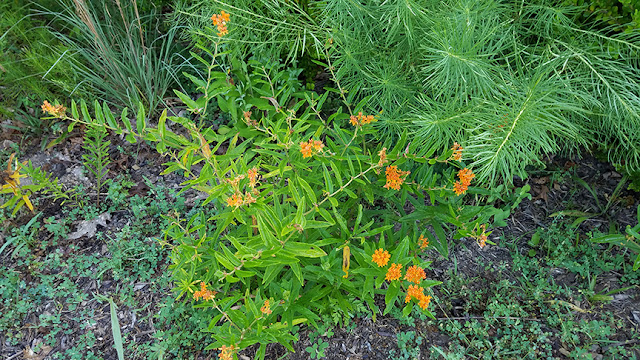 |
| Clary sage (Salvia sclarea) |
 |
| Clary sage |
This summer the deer have been incredibly voracious--they haven't left me very many flowers to show! One they haven't touched is the biennial Clary sage I planted last year. The flower spikes are big and bold, I'm sure their musky smell is the reason they've been left alone.
 |
| Centaurea cyanus 'Emperor William' |
The nearby Centaurea 'Emperor William' which I grew from seed a couple of years ago, has been reseeding itself ever since, but this year, the seedlings all got chomped back and only this one plant somehow managed to avoid being eaten. I love their bright blue color!
 |
| Butterfly weed (Asclepias tuberosa) |
Butterfly weed is another plant deer don't eat much, although they managed to eat the flower buds of all the 'Hello Yellow' ones--these plants are just finishing their cycle of bloom. The Buddleias are starting their show--with the extreme drought in our area and barely enough rain to bring relief, nothing is looking too great, only a few flower spikes where normally bloom would be profuse.
 |
| Butterfly bush (Buddleia davidii) |
 |
| Buddleia Pugster 'Miss Molly' |
 |
| Buddleia lindleyiana |
The Buddleia lindleyiana is a native of Japan and is doing well in my Virginia garden, but I'm discovering that it likes to sucker, and needs more room. I love the graceful arching flower spikes, and the pollinators really like this variety: butterflies, bees and hummingbirds.
 |
| Bottlebrush buckeye (Aesculus parviflora) |
Speaking of plants beloved by pollinators, my Bottlebrush buckeye is about to bloom--it's a bit late this year, it's usually in full bloom by now. My tree is now about 6 foot tall and wide, it will probably reach its mature height of about 10 feet in a few years.
 |
| Seven Son Flower Tree (Heptacodium miconiodes) |
The Seven Son Flower Tree, which normally doesn't bloom until August, budded out very early and has started to open its small clusters of seven flowers each. This shrub is a native of China, but still attracts lots of native pollinators such as dark swallowtails, and the hummers too.
 |
| Coneflowers under the Seven Son Flower Tree |
 |
| Close-up of Coneflowers. |
The back bed with a variety of Coneflowers and other blooming plants lies under the Seven Son Flower Tree, but this year, the coneflowers have been decimated--very few are left. I really need to be more proactive in spreading deer repellent or there'll be nothing left to show for all my labors.
 |
| Crocosmia 'Lucifer' |
 |
| Clematis 'True Love' |
Again, these Crocosmia and clematis flowers above are the only ones left from the deer's depredations. The heather below grows under a wire cloche, or there would be nothing left of either foliage or flowers.
 |
| Heather. |
On the east side of the house, the hydrangea 'Incrediball' is lovely, the other hydrangeas have been chewed up a lot--only one flower left on the lace-cap hydrangea, the one on the other side of Incrediball (behind) has not a single flower left! 'Little Quick Fire' hydrangea sustained very little damage, but the Oakleaf hydrangea 'Ruby Slippers' is standing only because of the tomato cage protecting it.
 | |
| Hydrangea 'Incrediball' |
 | |
| Hydrangea 'Little Quick Fire' |
 |
| Oakleaf hydrangea 'Ruby Slippers' |
Lavenders are among few flowers that deer don't go for, and the mint family is also generally spared.
 |
| Lavender 'Grosso' |
 |
| Hoary mountain mint with Ninebark tree 'Coppertina' |
Salvias are not appetizing to deer either, and generally spared--I bought the one below at Green Springs Gardens, where our botanical artist group had a show this spring, and deadheaded it--it's starting to re-bloom. I thought that zinnias were immune to deer too, but this year my seedlings have been decapitated.
 |
| Salvia |
 |
| Vitex agnus castus |
The Vitex above is usually in full bloom at this time, but with the current drought, growth has slowed down so much!
The plants on the deck and hanging baskets are out of the deer's reach, of course, so I may still enjoy those flowers.
 |
| Cuphea 'Hummingbird's Lunch' on the back deck. |
 |
| Hanging basket on the porch. |
 |
| Calibrachoas on the deck. |
The Cuphea 'Hummingbird's Lunch' hasn't attracted many hummers, but well I remember how one evening last year, in late September, a lone female hummingbird, apparently starved, came and gratefully buzzed every flower.
To sum it up, this July I'm short of flowers to show. Let's pray for some good rains in our area soon, so that I may have something in bloom to show you next month!




























